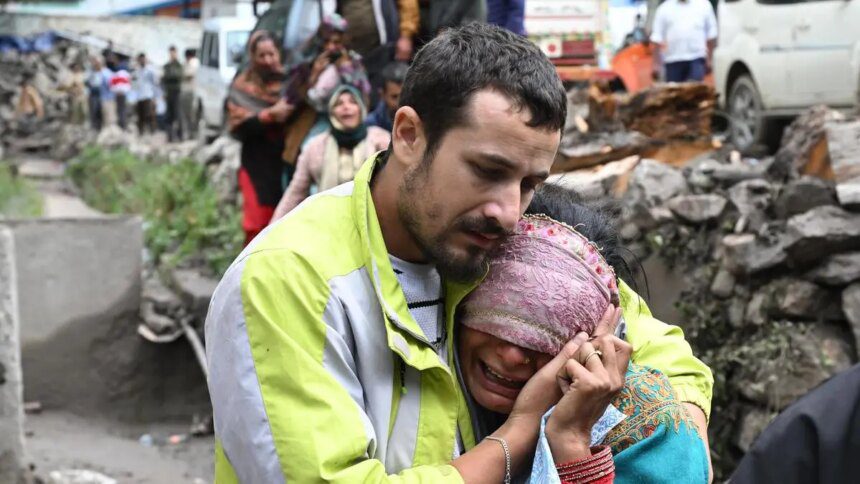RAINING MISERY: Death, destruction and sorrow brought in by a cloudburst in Kashmir in August | Photo Credit: IMRAN NISSAR
Last month, research consultancy Climate Trends’ report titled ‘Enhancing multi-hazard early warning and resilient settlement in the Himalayan region’ was released at a stakeholder consultation in Dehradun.
Authored by Dr Palak Balyan, with contributions by Alok Kumar and Sayalee Gulhane, the report emphasised the urgent need for an action plan to safeguard our majestic mountains, unique glaciers, rich biodiversity and local communities from utter ruin and extreme hardship.
Recent events have underscored the need to ensure that the destructive changes in the Himalayas do not become irreversible. The report states that the “Himalayan glaciers are retreating at unprecedented rates, forming unstable moraine-dammed lakes that pose significant glacial lake outburst floods (GLOFs) risks”.
It dwells on the flash floods in August this year that ravaged Dharali village in Uttarakhand, and the cloudburst and landslide in Kashmir that left a trail of death and distraught pilgrims. In 2023, GLOFs in Sikkim’s South Lhonak destroyed a hydropower infrastructure.
The authors also reflect on the “growing fragility” of the region and how “changing climate patterns and poorly planned infrastructure interact to amplify hazards”. This includes the unplanned settlements in the mountain towns as the population grows, amid rising migration. In recent times, dwellings have come up along the river, on steep slopes, and in spaces that are vulnerable to floods, erosion and landslides. The report calls it “unregulated construction and settlement expansion in high-risk zones”.
Course correction
So, what must India do?
The authors attempt to draw up an action plan for the Himalayas after referring to international models in Japan, Switzerland and Norway. The idea is to step up resilience among the people in the face of more frequent landslides, cloudbursts, flash floods, and GLOFs. This calls for a robust early warning system that can save lives and minimise economic loss. The report goes into the minute details of the agencies that should be involved in this exercise and the action to be taken.
With the National Disaster Management Authority (NDMA) as the pivot, it recommends the involvement of the India Meteorological Department; the Central Water Commission; the Geological Survey of India; the Ministry of Environment, Forest and Climate Change; the Ministry of Health and Family Welfare; the National Disaster Response Force; and the Indian Space Research Organisation (ISRO).
Emergency response
Calling for “strengthening governance and legal triggers”, the report suggests forming a ‘Himalayan Risk Council’ for coordination without overlaps.
Hazard warnings linked to legally binding triggers can ensure immediate emergency response such as shutting down roads, evacuating schools, and suspending rain-flooded routes, among others.
Hazard zoning must be integrated into State plans, with a ban on construction or relocation in red zones, and enforcing stricter building codes in orange or yellow zones.
To make the system more scientific, data gaps must be plugged across the region and models must be developed to convert rainfall and soil data into landslide warnings. Simulating GLOFs and avalanche dynamics, and formulating advisories in simple local language would be hugely helpful.
Effective community-based measures include installing early warning systems at the village level, and training local volunteers in siren operations, shelter management, and guiding schools, hospitals and other institutions in following standard operating procedures.
Funding support
Of course, all these measures call for adequate funds. For this, the report underscored the establishment of a ‘Himalayan Resilience Fund’, pooling international and national resources.
And this brings us back to what COP30 is trying to achieve — an enhanced flow of funds to help mitigate disaster risks of the kind facing the Himalayan range and the vulnerable communities living in its lap.
More Like This
Published on November 10, 2025










